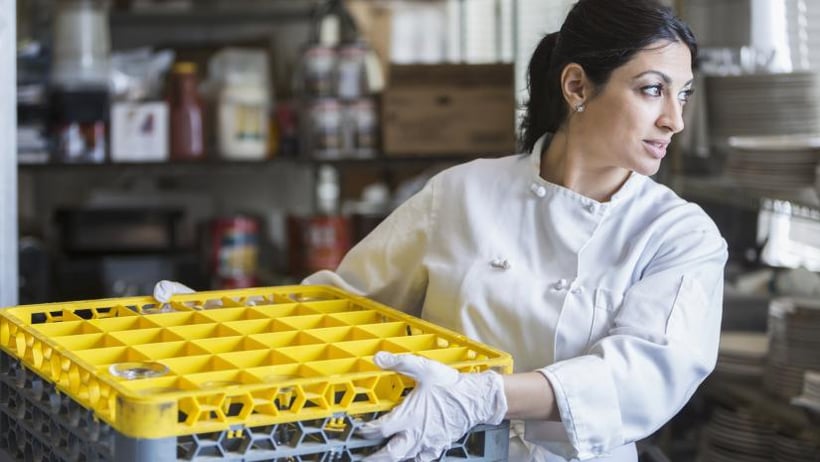
From full-service restaurants and hotels to hospitals and healthcare facilities, regular cleaning and sanitizing are essential to ensuring food safety wherever food is handled in a commercial kitchen.
Many food-borne illness outbreaks occur as a result of poor cleaning and sanitizing procedures, and different kitchen items will require a different approach.
When deciding on the best approach to take for cleaning and sanitizing, these are some aspects to take into consideration:
- The item to be cleaned
- The type of soiling
- The water supply
- The water temperature available
- The appropriate cleaning and sanitizing agents
The three most common cleaning methods used in commercial kitchens are:
- Manual cleaning
- Mechanical cleaning
- Clean-in-place cleaning
Note: To ensure food safety, cleaning must always be followed by sanitizing. For the purpose of this article, "cleaning" refers to cleaning and sanitizing.
Let's explore each method in a little more detail.
Manual cleaning
Manual cleaning of a commercial kitchen is a six- or seven-step process, depending on the sanitizing method used. It involves:
- Removing dirt, grease and food scraps
- Rinsing
- Cleaning with an appropriate cleaning agent (e.g. detergent, degreaser)
- Sanitizing using a chemical sanitizer or hot water
- Air drying
Visual reminders of the cleaning and sanitizing process, as well as quick reference guides for cleaning and sanitizing agents, can be very useful for staff training and for ensuring food safety in a commercial kitchen or community feeding organization.
CIFS members can download these resources and more from the CIFS Resource Library. Learn about the benefits of CIFS Membership.
Mechanical cleaning
Mechanical cleaning involves using a dishwasher or other automated cleaning equipment. Most food businesses use a combination of manual and mechanical cleaning and sanitizing for their commercial kitchens.
Some machines use a high-temperature rinse to sanitize, while others use a chemical sanitizer.
If using a mechanical dishwasher to clean and sanitize items, the steps are similar to manual cleaning. To start, scrape and rinse off as much food residue as possible before loading the machine.
Avoid overloading the machine, as this can prevent items from getting properly cleaned and puts unnecessary wear and tear on the machine.
Depending on the sanitizing method used by the machine, some or all of the following checks should be performed daily:
- Maximum water temperature
- Chemical concentration
Always follow the manufacturer’s instructions for the mechanical dishwasher and keep it in good repair. Failure to do so could cost you points on your next health inspection.
Clean-in-place cleaning
Some commercial kitchen equipment is designed to be ‘cleaned in place.’ Clean-in-place cleaning is generally done if the item being cleaned is too large or too cumbersome to be moved, or if it is fixed in place. Soft-serve ice cream machines, pop dispensers and espresso machines are all examples of the types of machines that would require the clean-in-place method.
These types of machines are usually designed with pipes or other features that allow cleaners, sanitizers and hot water to be flushed through the system, eliminating built-up grime and microorganisms.
Always follow the manufacturer’s instructions to avoid damaging the machines or contaminating food/beverages with harsh chemicals that could make somebody sick.
The importance of cleaning and sanitizing
Commercial kitchen cleaning and sanitizing is crucial. If you or your Food Handlers are not adequately cleaning and sanitizing, you’re putting your customers and your business at risk.
Additionally, effective cleaning and sanitizing:
- Prevents pest infestations, which can increase operational costs and damage your reputation
- Helps to ensure that your business/organization passes its health inspections and avoids costly fines or closures
-
Helps to protect customers/clients/care recipients from food poisoning and other health risks, like allergic reactions to food ‒ the outcomes of which can include severe illness or even death
Food Handlers must receive food safety training to ensure they know how, what, and when to clean and sanitize, as well as the risks of not following proper procedures. Frequent, rigorous cleaning and sanitizing of your commercial kitchen will help to prevent this from happening in your food business.
To learn more about food safety training, contact the Canadian Institute of Food Safety.
Frequently Asked Questions
What specific chemicals or detergents are recommended for each cleaning method in commercial kitchens?
For commercial kitchen cleaning, specific chemicals and detergents recommended for different methods include:
- Detergents: These are commonly used in both manual and mechanical cleaning methods to break up dirt and soil. They come in various forms such as powders, liquids, gels, or crystals, and are typically synthetic, made from petroleum products.
- Degreasers: Also known as solvent cleaners, these are essential for removing grease from surfaces like grill backsplashes, oven tops, and food preparation counters. Modern degreasers are often non-toxic and non-fuming, making them safer for use in food service environments.
- Abrasives: Used for scrubbing hard surfaces like pots, pans, and floors, abrasives can help remove tough grime but should be used cautiously on materials like stainless steel or plastic to avoid scratching.
- Acids: Powerful cleaning agents used for descaling dishwashers, removing mineral deposits, and cleaning rust from surfaces. They must be handled with care due to their corrosive nature.
- Descalers: Used specifically to remove hard water and mineral deposits, particularly around dishwashing areas and heating elements, helping to maintain equipment efficiency and longevity.
Using these cleaning agents properly ensures a clean and safe kitchen environment, meeting health and safety regulations and preventing food contamination.
How often should each type of cleaning (manual, mechanical, clean-in-place) be performed in a commercial kitchen?
The frequency of cleaning in a commercial kitchen depends on the type of cleaning method being used. Here's a general guideline:
Manual Cleaning:
- Daily: Manual cleaning of surfaces, utensils, and equipment should be done daily. This includes wiping down counters, stovetops, and other frequently used surfaces.
- Weekly: Deep cleaning tasks such as scrubbing grills, ovens, and fryers should be conducted at least once a week.
- As needed: Any spills or immediate messes should be cleaned up promptly to maintain hygiene and safety.
Mechanical Cleaning:
- Daily: Dishwashers and other mechanical cleaning equipment should be used daily to clean dishes, glasses, and utensils. These machines often have cycles that include both cleaning and sanitizing phases.
- Monthly: Regular maintenance checks, such as verifying water temperature and chemical levels, should be performed monthly to ensure the machines are operating effectively.
- Daily: CIP systems used for equipment that cannot be easily disassembled (like ice cream machines or beverage dispensers) should be cleaned daily to prevent microbial buildup.
- Weekly/Monthly: Depending on the equipment and usage, some CIP systems might require a more thorough cleaning weekly or monthly. Always follow the manufacturer’s guidelines for the specific equipment.
These schedules can vary based on the specific requirements of your kitchen and local health regulations. It’s crucial to adhere to both the manufacturer's recommendations and regulatory standards to ensure food safety and compliance.
Are there any specific regulatory requirements or standards for commercial kitchen cleaning that businesses must adhere to in Canada?
Yes, there are specific regulatory requirements and standards for commercial kitchen cleaning that businesses must adhere to. These regulations ensure food safety, worker safety, and overall hygiene in the food service environment.
Federal Regulations
- Food and Drugs Act and Regulations: Governed by the Canadian Food Inspection Agency (CFIA), this act includes provisions for maintaining clean and sanitary conditions in food establishments.
- Safe Food for Canadians Regulations (SFCR): These regulations apply to businesses involved in manufacturing, processing, treating, preserving, grading, packaging, or labelling food for trade.
Provincial and Territorial Regulations
Each province and territory in Canada has its own health and safety regulations that cover commercial kitchen cleaning. Some examples include:
1. Ontario- Health Protection and Promotion Act: Managed by local public health units, this act includes regulations for maintaining sanitary conditions in food premises.
- Ontario Food Premises Regulation (O. Reg. 493/17): This regulation outlines specific requirements for sanitation, maintenance, and equipment cleaning.
- Public Health Act: Enforced by the BC Centre for Disease Control, this act includes guidelines for food safety and sanitation in commercial kitchens.
- Food Premises Regulation: This regulation details the standards for cleanliness, equipment maintenance, and hygiene practices.
- Food Products Act: Overseen by the Ministère de l'Agriculture, des Pêcheries et de l'Alimentation du Québec (MAPAQ), this act includes provisions for maintaining clean and sanitary food premises.
- Regulation Respecting Food: This regulation sets out detailed requirements for sanitation, equipment cleaning, and hygiene practices.
- Specific cleaning schedules and procedures.
- Requirements for waste disposal and pest control.
- Inspections and enforcement by local health inspectors.
- Hazard Analysis and Critical Control Points (HACCP): A systematic preventive approach to food safety that addresses physical, chemical, and biological hazards through proper cleaning and sanitation procedures.
- ISO 22000: An international standard for food safety management systems that includes guidelines for maintaining clean and sanitary conditions.




